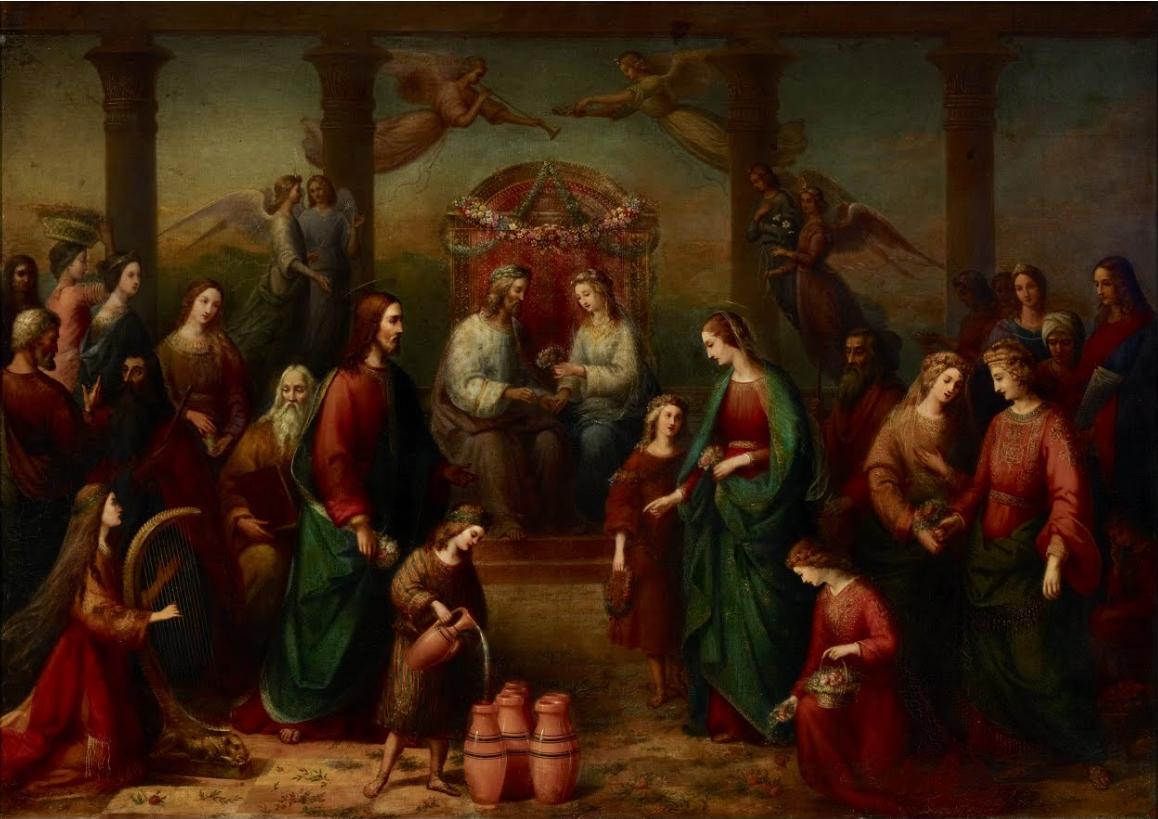
The Second Sunday in Ordinary Time
♦
The Second Sunday in Ordinary Time
Mary Louise Chesley-Cora
16 January 2019
Last week we celebrated the Baptism of the Lord. This week we move into the public ministry of Jesus as he joins a wedding celebration in Cana of Galilee (only mentioned in John’s gospel). This wedding feast, the place where food is shared, offers a privileged place of revelation, a place of worship, liturgy, and the preaching of the good news. (p. 107, McKenna) (The passage omits the opening phrase which is “On the third day” evoking the memory of the Resurrection.) The mother of Jesus is the first one mentioned along with Jesus and his disciples. John never names Mary in his Gospel but she is seen in intimate relation with her son at the beginning and end of his public life. It is she who notices that the wine is running out and calls on her son to do something about it. This running out of wine reflects the long awaited time that the people have yearned for a Messiah. Jesus’ response to her request to provide the needed wine was “Woman, your thoughts are not mine! My hour has not yet come”, (an unheard of way to address one’s mother). Mary, however, moves to the hallways, into the place where the servants are stationed and bids them to do whatever Jesus tells them to do. They in turn follow his directions. This incident in John’s gospel is the 1st of the signs that usher in the new kingdom and understanding of who Jesus really is. It is also a sign of compassion and concern for the newlyweds. It shows that the kingdom comes as a response to the needs of others. Jesus follows the commands of his mother, who is church, the new people of God, the new covenant. (p.109 McKenna).
Isaiah also speaks of a wedding feast – one between God and the chosen people. In this passage, the exile is officially over and the Jews are returning back to their homeland to rebuild Jerusalem. The prophet gives them a sense that God indeed loves them much like the love that unites a husband and his wife. This offers them a real sign of hope for renewal in the days and years ahead. God’s love is a constant in the midst of their trials. Psalm 96 reflects their praise and rejoicing as they “Sing a new song to the Lord”(vs. 1). They recognize God’s wondrous deeds among them and the nations and give God glory and thanks.
Paul’s letter recognizes the diversity of gifts that flow from the Spirit of Jesus. These gifts also come from a covenant relationship as in a marriage. There are many charisms but all come from the same Spirit, the same Lord, the same God. There is a great diversity to meet the needs of the diverse peoples loved by God. Each person in the community is given certain gifts to enrich the Body of Christ. No one person has all the gifts. (Sometimes we may give our pastors the sense that we expect that of them!) Gathering as a community of faith is key to building up the Body of Christ. There is need for Sophia wisdom, knowledge, faith, healing, prophecy and ways to discern the direction of the Holy Spirit. It is through the coming together in prayer, worship and service that the spiritual gifts can be discerned and shared. We go forth in love to serve God and all those we meet each new day.
For reflection and Discussion: How often do you connect a Marriage covenant with your relationship with God? What do we learn about Mary from this Gospel passage? About her son, Jesus? As the year begins, what gifts are most needed in your community of faith? What does it mean to you to “Do whatever he tells you?”
Bibliography: Mary – Shadow of Grace, Megan McKenna (New York City Press, 2007); The Jerome Biblical Commentary (Prentice-Hall, Inc. NJ, 1968)

The marriage at Cana of Galilee
Adelaide Ironside 1861 reworked 1863
The first Australian-born artist to study in Europe, Adelaide Ironside aspired to history painting, the highest category of art in her day. ‘The marriage at Cana of Galilee’ 1861/1863 – the most important painting of her career – portrays Christ’s first public miracle, the transformation of water into wine during the marriage feast at Cana in Galilee.
Painted in Rome, ‘The marriage’ was exhibited at the Colonial Court of the 1862 International Exhibition in London. It was returned to Sydney after the artist’s premature death, and was owned for many years by the all-male St Paul’s College, University of Sydney.
Source: Google Arts & Culture

This week’s teaching commentary was prepared by
Mary Louise Chesley-Cora, MAT in Religious Studies,
Hockessin DE USA.
Bat Kol Alumna 2001
PLEASE NOTE: The weekly Parashah commentaries represent the research and creative thought of their authors, and are meant to stimulate deeper thinking about the meaning of the Scriptures. While they draw upon the study methods and sources employed by the ISPS-Ratisbonne, the views and conclusions expressed in these commentaries are solely those of their authors, and do not necessarily represent the views of ISPS-Ratisbonne. The commentaries, along with all materials published on the ISPS-Ratisbonne website, are copyrighted by the writers, and are made available for personal and group study, and local church purposes. Permission needed for other purposes. Questions, comments and feedback are always welcome.
Share this with your friends
Institute Saint Pierre de Sion – Ratisbonne – Christian Center for Jewish Studies
Congregation of the Religious of Our Lady of Sion
Contact us:
secretary@ratisbonne.org.il
26 Shmuel Ha-Naguid Street – Jerusalem
Subscribe to Newsletter

No responses yet